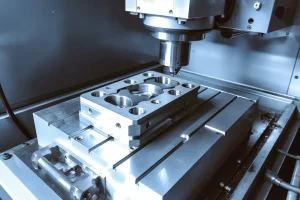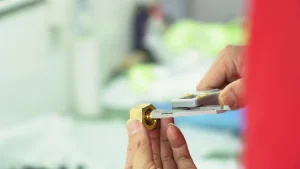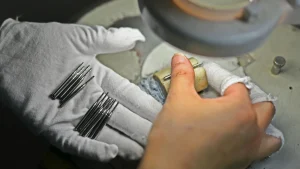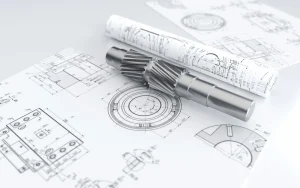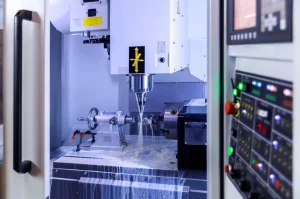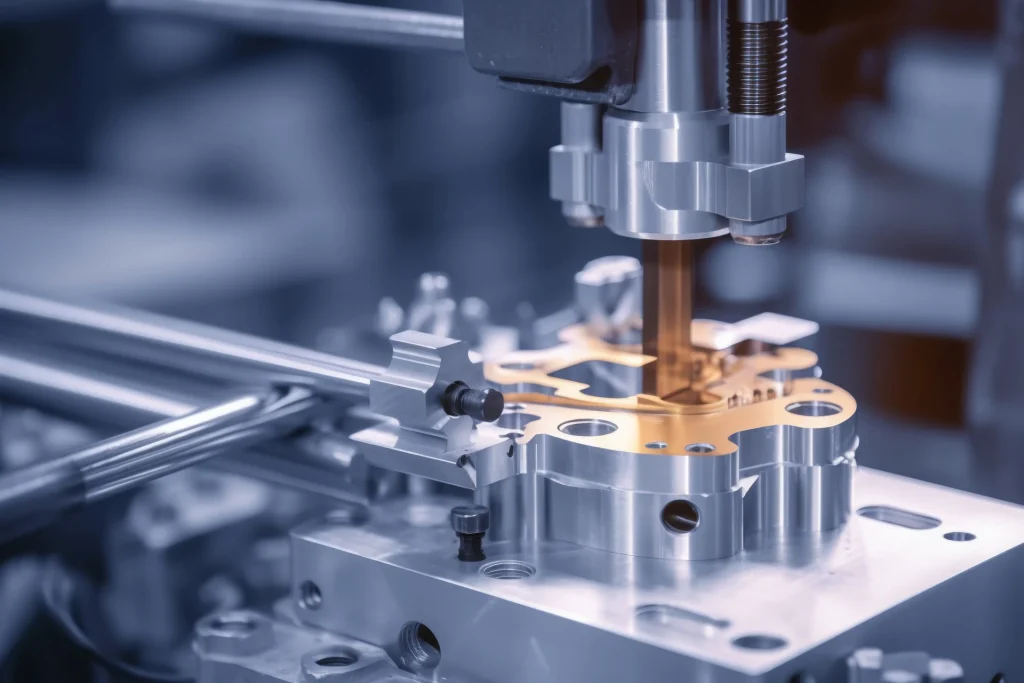
1. Physical performance requirements
Hardness
Processing adaptability: 用于精确零件处理, 材料硬度应该适中. 如果材料太难了, such as some high-hardness alloy steels, the tool will wear quickly during processing, and the processing difficulty will increase. Special tools and processing techniques may be required. 例如, mold steel with a hardness of HRC60 or above is difficult to be effectively processed by ordinary carbide tools during milling, 和立方硼硝酸盐 (立方氮化硼) tools or ceramic tools are required. If the material is too soft, such as pure aluminum, it is easy to deform during processing, affecting the accuracy of the parts, so it is also necessary to choose a suitable processing method, such as high-speed cutting and controlling the cutting force.
表现: Precision parts need to withstand certain external forces during use, and appropriate hardness can ensure their wear resistance and deformation resistance. 例如, the tooth surface of precision gears in mechanical transmission needs to have a higher hardness (generally HRC45-60) to ensure that there will be no excessive wear and tooth deformation during long-term meshing transmission, thereby ensuring transmission accuracy.
Strength and toughness
Fracture resistance: Precision parts may be subjected to external forces such as cutting force and clamping force during processing, and will also bear various working loads during use. The material needs to have sufficient strength and toughness to prevent fracture. 例如, precision parts in the aerospace field, such as the blades of aircraft engines, must withstand huge centrifugal forces and complex gas forces during high-speed rotation. Materials (such as titanium alloys) need to have high strength and good toughness to avoid blades from breaking during operation and causing serious accidents.
Processing quality assurance: In precision processing, the toughness of the material cannot be too high, otherwise it is easy to produce tool sticking during cutting, affecting the surface quality of the parts. 例如, when turning some high-toughness stainless steel, the chips are easy to wrap around the tool, resulting in increased surface roughness. It is necessary to use a suitable chip breaker tool or change the cutting parameters to solve this problem.
Coefficient of thermal expansion
Processing accuracy control: During the processing of precision parts, due to factors such as cutting heat, the parts will produce thermal deformation. The smaller the thermal expansion coefficient of the material, the smaller the thermal deformation during processing, which is conducive to ensuring processing accuracy. 例如, in the precision grinding process of optical lenses, quartz materials are often used, which have a very small thermal expansion coefficient. Even if a certain amount of heat is generated during the grinding process, the size change of the lens is very small, which can ensure that the lens after grinding can achieve high shape accuracy and surface quality.
Stability of use: For some precision parts working in a temperature-changing environment, such as key components of precision measuring tools and instruments, the small thermal expansion coefficient of the material can ensure the dimensional stability of the parts at different temperatures, thereby ensuring its measurement accuracy and working performance.
2. Chemical performance requirements
耐腐蚀
Process protection: During the processing of precision parts, some processing techniques may expose the parts to corrosive media. 例如, in electrochemical processing or chemical grinding, parts need to resist corrosion from processing fluids. Selecting materials with good corrosion resistance can reduce protective measures and post-processing procedures during processing. 例如, stainless steel materials can still maintain good stability in processing fluids containing a certain amount of salt, reducing the risk of rust.
Adaptability to the use environment: Precision parts may be exposed to various corrosive substances in the actual use environment. 例如, precision valve parts in chemical equipment are exposed to various corrosive chemicals such as acids and alkalis, so it is necessary to use materials with strong corrosion resistance, such as Hastelloy. This alloy contains elements such as nickel, 钼, and chromium. It can maintain good chemical stability in a variety of strong acid and alkali environments, ensuring that the precision control function of the valve is not affected by corrosion.
Antioxidation
Maintaining quality after processing: After the precision parts are processed, if the material has poor oxidation resistance, the surface of the parts is easily oxidized during storage and use, forming an oxide film, which affects the appearance and performance of the parts. 例如, high-precision copper parts are easily oxidized in the air to form verdigris. If effective protection is not performed, the dimensional accuracy and surface quality of the oxidized parts will decrease.
High-temperature working environment requirements: In some high-temperature working environments, such as precision parts inside aircraft engines, materials need to have good oxidation resistance. 例如, nickel-based high-temperature alloys can form a dense oxide film at high temperatures to prevent oxygen from further invading the material, ensuring the stability of the performance of the parts in high-temperature environments, and preventing material performance degradation and part damage caused by oxidation.
3. Requirements for purity and uniformity of materials
Purity
The impact of impurities on performance: Impurities in precision parts materials can have a serious impact on their performance. 例如, in semiconductor precision processing, the purity requirements of silicon materials are extremely high. Even trace impurities (such as metal impurities) can change the electrical properties of silicon and affect the performance and reliability of the chip. High-purity silicon materials (purity of more than 99.9999%) are the basis for ensuring high-precision processing and high performance of chips.
Processing quality association: Impurities in materials may also cause processing defects during processing. 例如, in steel materials, if there are more inclusions (such as sulfides, oxides, 等), these inclusions may cause stress concentration during forging or cutting, resulting in cracks or surface defects in parts, reducing the quality and precision of parts.
Uniformity
Uniform physical properties guarantee: The uniformity of materials includes composition uniformity and organizational structure uniformity. 用于精确零件处理, uniform materials can ensure that the physical properties of each part of the part are consistent. 例如, when manufacturing precision molds, the uniform composition and organizational structure of the steel can ensure that the hardness, strength and wear resistance of each part of the mold are the same during use, thereby ensuring the molding accuracy and service life of the mold.
Processing process adaptability: Uniform materials are easier to control the processing quality during processing. 例如, in EDM, uniform conductive materials can ensure a stable discharge process and higher processing accuracy. If the conductivity of the material is uneven, it will lead to uneven discharge energy, increase the roughness of the processed surface, and reduce the dimensional accuracy.

